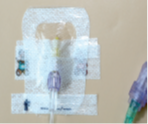Information for parents and carers
On this page
- Download leaflet
- What is a drip / cannula?
- Why does my child need a drip / cannula?
- Do I have to give my permission for it to be put in?
- How can my child be prepared?
- Will my child need a General Anaesthetic (G.A.)?
- How long will it take to put in?
- Will it hurt?
- Are there any side effects or complications
- What are the benefits?
- Is there any other treatment that my child could have?
- What will it look like?
- Can my child go home with a drip / cannula?
- Aseptic Non-Touch Technique (ANTT)
Download leaflet
Cannula My Child Needs A Drip PIAG 77 (252kB)
What is a drip / cannula?
A drip / cannula is a small tube that is inserted into small veins located in the hands, arms, feet and occasionally scalp.
Why does my child need a drip / cannula?
Cannulas are used to deliver medication, blood products and fluids directly into the vein/bloodstream (intravenously).
Do I have to give my permission for it to be put in?
Usually the reason why a cannula is needed will have been explained before it is inserted. However if treatment has to start straight away a cannula can be inserted without consent.
How can my child be prepared?
A Play Specialist can be present before and during the procedure to provide preparation and distraction therapies.
Will my child need a General Anaesthetic (G.A.)?
Your child will not require a GA, a local anaesthetic cream (magic cream) will be applied before the cannula is inserted to numb the area. The nurse or doctor will insert the cannula once the cream has been on for approximately one hour.
This leaflet only gives general information. You must always discuss the individual treatment of your child with the appropriate member of staff. Do not rely on this leaflet alone for information about your child’s treatment.
How long will it take to put in?
This varies from child to child. The procedure can be quick in some children; however, it can take longer if the vein is difficult to find.
Will it hurt?
Needles can hurt however, the ‘magic cream’ helps to minimize pain and discomfort during the procedure. The cream may be applied to several areas to give the doctor or nurse a choice of the best vein to use.
For babies up to 6-8 weeks of age, sucrose (a sugar-based liquid) an alternative is used, it is dripped onto the dummy or your babies’ tongue, before and during the procedure. It helps to distract your baby from the procedure.
Are there any side effects or complications
The area where the ‘magic cream’ has been applied can sometimes become red. This usually settles within a short space of time. An alternative local anaesthetic cream called EMLA is available, if required.
The site where the cannula is will be checked regularly by your child’s nurse so any potential complications will be picked up early. These can include redness, swelling or tenderness. If you are concerned, please speak to a member of the nursing staff.
What are the benefits?
Your child will be able to receive the medication and fluid they need quickly.
Is there any other treatment that my child could have?
Some medication can be given orally, however certain medication can only be given intravenously.
What will it look like?
Once the cannula is in, it will be secured with a ‘teddy bear dressing’. The picture below shows what it will look like.

It may also be covered with an extra covering called tubifast, which is a soft cotton covering (alternative to a bandage).
Can my child go home with a drip / cannula?
It is unlikely that your child will go home with a cannula. The cannula will almost always be removed before your child returns home.
Only in certain circumstances will a cannula be left in for your child to receive treatment at home. This would be discussed before your child returns home.
Aseptic Non-Touch Technique (ANTT)
Your child’s cannula will be accessed in order to deliver medication, blood products or fluids via a trained nurse or doctor. The technique used to access you child’s cannula is called Aseptic Non-Touch Technique (ANTT). This is an evidence based clinical practice for preparation and administration of intravenous therapy. Research shows that using ANTT is best clinical practice for accessing intravenous lines and reducing risk of infection.
You should see:
• The nurse / doctor clean their hands with soap and water or alcohol gel.
• Put on a pair of gloves prior to accessing your child’s line.
• Scrub the end of the intravenous line device for 20 seconds with a large wipe and allow it to dry for 20 seconds.
• Gather all equipment safely and remove it from your child’s bed space once the medication has been administered.
This information can be made available in other languages and formats if requested.
PIAG: 77